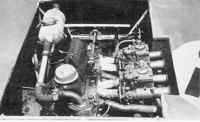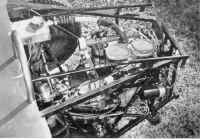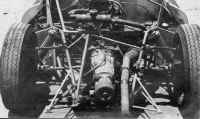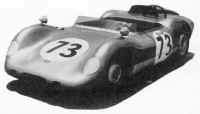 Neat overall appearance of the semi-home-built Modified is somewhat spoiled by the FIA windshield required at Sebring.
Neat overall appearance of the semi-home-built Modified is somewhat spoiled by the FIA windshield required at Sebring. Neat overall appearance of the semi-home-built Modified is somewhat spoiled by the FIA windshield required at Sebring.
Neat overall appearance of the semi-home-built Modified is somewhat spoiled by the FIA windshield required at Sebring.
BY WALLY KORB
PHOTOS: ALICE BIXLER - WALLY KORB - JEF STEVENS
FEW ENTHUSIASTS who have ever decided on the "special" route to racing would ever deny that it is almost as rough as the rocky, rocky road to love. At times it probably seems as though there are an insurmountable number of debits stacked against any possible credits they can ever manage to dredge up from their vast store of patience. And, when the whole effort is tallied up, the usual question is almost inevitable - "Why, in the name of good common sense, does anyone ever decide to build a special?"
Actually, there are several reasons, and to some people, at least, they mean a great deal. There is, of course, the most obvious reason that building a special can mean the builder will have a truly competitive car at a fraction of the cost that others may spend on their more normally produced machinery. And, there is the reason that quite a few drivers with mechanical ability simply prefer to build their own car. But perhaps the most important reason of all is the honest thrill that a few special builders are able to derive from smacking the devil out of the factory competition.
At this point in the procedure -giving the factory boys a case of the fidgets, that is-we very often come up against a bit of a bind. Beating a factory setup with strong desire, even coupled with an aim at specific goals rather than that of acceptance from the general public, is not a simple task. Against these relatively puny forces, the factories can throw their elaborate research and development teams, not to mention the much larger amounts of capital backing which they have. Even though most factories are most helpful in aiding special builders in extracting optimum performance from their components, it is not too surprising that many of the backyard boys are doomed to disappointment, if not downright failure.
At any rate, Henry Grady and Gene Beach have been overcoming some of these handicaps since early 1959, when they built their first Begra. In addition, add the complication of Grady living in Miami, Florida, while Beach resides in Clearwater, almost 300 miles away on the opposite coast. Mention in the same breath that their efforts have been crowned with almost overwhelming success, and you begin to understand the tremendous amount of planning and teamwork which they have exerted. Perhaps the underlying theme of this teamwork can best be typified in the name they have chosen for their project, compounding the BE in Beach and GRA in Grady into "Begra."
Their first car was built under rather unique conditions. A new Fiat 600 was purchased at dealer cost and moved into Gene Beach's garage after having run only about 15 miles. Here the engine was pulled out of the car and the remainder turned over on its side and completely stripped of running gear, controls, battery, and all parts which the two wanted to use on thir Begra. Then small steel plates were drilled and bolted to the mounting holes on the stripped chassis, and these plates were connected by a light framework of electrical conduit all neatly welded together. This framework was then unbolted from the chassis and functioned thereafter as a jig for the actual chassis welding. The light space frame which resulted from this method of manufacture was not very exotic in Grady's opinion, but it did prove a good solid foundation from which to start. Basic Fiat 600 geometry was used entirely in setting up this first car, and it proved to be a remarkably good system according to later results. Furthermore, after the body shell had been used in such manner, it was sold back to the original Fiat dealer.
Meanwhile, modifications were made to the engine that resulted in considerable power increase. The engine was bored 3-1/4 mm and stroked 3-1/2 mm, to give a total displacement of 748 cc. A good bit of previous research had turned up the interesting fact that Hillman pistons in 0.010-inch oversize would fit the new bore exactly, and they were installed. Later tests on a Miami accelerometer indicated that the now-750 cc engine was producing slightly over 40 horsepower in the state of tune in which it was eventually installed in the first car.
Meanwhile, in Clearwater, Gene Beach was producing the design and labor which was to result in an aluminum body of very light weight. When the chassis and body were finally united in Clearwater, early in 1960, results were a little Class H beauty of just over 800 pounds wet weight. The whole project was rushed to completion just in time to be entered in the SCCA races to be held in Cocoa the following week. Here, in the first event of its scarcely completed young life, the Begra with Gene Beach at the wheel romped off to a clean Class win, placing Third Overall against TR, Porsche Normal, Alfa, and MGA competition.
In spite of other class wins at Daytona, in the same year, Grady and Beach were eventually forced into the realization that if success was to continue, more power would have to be available. Even with good power and light overall weight resulting in a weight/power ratio of under 16, excluding driver, the Begra could not be competitive with really topnotch Class H'ers. Shortly after Begra Mk I was sold to Jerry Morgan of Eau Gallic, Florida, Beach and Grady approached him with the idea of installing a SAAB powerplant in a bid to obtain more competitive power for the car.
If sufficient funds had been available at this time to enable outright purchase of a new SAAB GT engine, this project might have been relatively simple. Instead, the cheaper but more complicated route had to be chosen - that of attempting to modify a stock SAAB engine to GT specifications. Tracings of intake, exhaust, and transfer ports were made from a friend's GT engine, and the delicate work of modifying a stock SAAB head was begun. This accomplished, the next step was to obtain a GT crank, but at the time SAAB was not particularly amenable to selling these cranks to anyone, except on an exchange basis. Finally they prevailed on the Jacksonville distributor to part with the desired item, and when all of the pieces were finally put together, behold, an engine which produced in the neighborhood of 55 horsepower.
In the interests of reliability, the SAAB clutch had to be retained, but mating this to the Fiat 600 transmission presented several problems. A 1/4-inch adapter plate enabled the engine to be bolted to the Fiat transmission, but the edge of the pressure plate had to be cut back about 1/s-inch to clear the bell housing, and a new driven disc was made up using a VW solid disc with a Fiat 600 female spline. Installation of the whole unit was made in a vertically upright position instead of the usual SAAB slant, which necessitated the fabrication of a new intake manifold to enable the twin throat Solex to be mounted in a level position.
Initial tests and races proved that the new engine installation was producing a lot more belt in the back, but unfortunately it could not be depended on to last for very long at a time. At the SCCA Nationals in Daytona late in 1959 [1960], the Begra started on the grid in 12th position, but when the first turn had been negotiated, it was in First. "It out-accelerated everything on the grid," Grady related, "but this only lasted about ? of a lap. From then on we were continually plagued with troubles with that engine. We didn't have any failures with it, and it didn't seem to want to come apart, but we just couldn't get it to run properly. It would run fine for a while, but then it would start to break up and then run well for a while. Then it would start missing at different speeds -one time it would miss at 4000, then at 6000, then at 4000 again. We racked our brains trying to find out what was the matter with that engine. We accidentally found out what was the matter with the engine about three or four months later. It turned out that the tachometer, which was an electric tach, was shorting out the ignition system. We disconnected the tach and it ran fine."



Various powerplants used in Begra models were: the Ford 105E at left, SAAB
in the middle and featuring veranda-style installation, and the twin-cam Abarth at the
right. Design errors are evident, but improve with each new car.
Late in December of 1959 [1960], Bill Ward, a mutual friend of Grady and John Bentley, induced John to enter a proposed new Begra in the 1960
[1961] Sebring. In spite of the fact that actual work on the new car had not even been begun, John was assured that the car could be ready in time, and Beach and Grady fell to work with a vengeance. Outside of a full week, which Grady took off to speed completion of the project, the car was completed in about eight weekends of feverish labor.
A decision was made to continue with SAAB power for the new car, and the company was immediately contacted to see if they would supply an engine tuned to Lime Rock specifications. This they agreed to do. Meanwhile, an entirely new spaceframe was being readied in Clearwater; a heavier, sturdier frame designed to run a twelve hour race with complete reliability. To beef up the front suspension, Fiat 1100 spindles were used, although the rear suspension and transmission-differential remained Fiat 600. In an effort to gain better braking, Fiat 1100 brakes were first installed, but they proved to be too much, so Fiat Multipla brakes were substituted. The standard ring and pinion gearing of 5.375 was retained, as were the standard gearbox ratios, although close ratios had been used on the first car. To provide sufficient fuel for the Sebring race, two fuel tanks were installed, giving a total capacity of 17 gallons. The larger tank, located along the right side of the car, necessitated a flatter curve in that flank of the body, contrasting with the left side which tucks under more gently.
During all of this activity, arrival of the SAAB GT engine was anxiously being awaited. Very little time remained when it did arrive, and it was hurriedly installed in the almost-completed car and moved over to Sebring about a week before the race. There the car was rushed to completion while the arrival of a SAAB representative to aid in tuning the engine was now momentarily expected. That he did not arrive until after the race started probably did not greatly aid the showing of the car, which, many readers will no doubt remember, was something less than spectacular. Grady relates, "We couldn't get the engine started, and when we did manage to get it started, you couldn't keep it running under 1600 revs." After touring around the Sebring course for about five hours, the car was finally retired. At this point, in due fairness to both sides of a possible controversy, Grady's words seem to sum up the whole thing pretty neatly. "We're not happy with SAAB, and SAAB's not happy with us."
Since Sebring of 1960 [1961], two other cars have been built by Beach and Grady, one for John Norwood using an Abarth Twin Cam engine in connection with a super-light chassis for a total weight of about 800 pounds, and the other for George Avant [Avent] of Kingstree, S. C., completed very recently and supplied without engine. Both of these cars are much lighter than the Begra Mk II run at Sebring, but, although a good bit of chassis design experience was gained from their building, neither has figured prominently in the overall picture of Begra as yet.
This statement should not be interpreted as a detractor from the Begra built for Norwood. (It could be designated as the Mk. III, although it has not been officially as yet.) Since the frame is the third product of the Grady combo, it is by far the most sophisticated of the lot, being much lighter than the Mk. II frame, and yet rigid enough to withstand the usual racing rigors. The suspension is very nearly the same as the Mk. II, which is the basis for this article, so it will not be elaborated on, except to mention that the rear hubs are an original design to give extra rigidity and lightness in that area. This car is the first of the Begras to use a powerplant which is not largely the work of Beach and Grady. Instead, it uses a Fiat-Abarth Twin Cam engine, mounted in the mid-position and driving through the rear mounted, inverted Fiat 600 transmission-differential unit.
With about 65 bhp pushing only 900 pounds of weight, this car should have been a tremendous success in its early outings, but lack of really reliable engine performance had always held it back -until the SCCA Regionals run at Osceola, Florida in early July, that is. Here, the car was able to turn laps of 2:26 over a tight 2.8-mile course anytime it needed to, and was able to stroke to easy, overall victories against its good, but not spectacular, competition. In the fourth race, for Production F, G, and H and Modified H cars, the Begra Mk. III won by nearly 50 seconds. Drver Gene Beach moved it up very easily over the last half of the race, keeping the engine temperatures from matching the blistering beat of the weather.
 To return to the story, the Mark II car was subsequently converted into a Class G car by the changeover to a Ford 105 E powerplant. Modification to the engine included a light alloy head, giving a compression ratio of 10-to-1, and the substitution of a "fairly mild cam" for the stock component. At first, twin Solex 40 PII carbs were added to a special intake manifold, but latest modification in search of additional power has changed these to twin 40 DCOE 2 Webers nestled snuggly between a beautifully fabricated tuned exhaust system. Further benefit from the switch to Webers will be the elimination of the bulky airscoop used previously in connection with the downdraft Solexes.
To return to the story, the Mark II car was subsequently converted into a Class G car by the changeover to a Ford 105 E powerplant. Modification to the engine included a light alloy head, giving a compression ratio of 10-to-1, and the substitution of a "fairly mild cam" for the stock component. At first, twin Solex 40 PII carbs were added to a special intake manifold, but latest modification in search of additional power has changed these to twin 40 DCOE 2 Webers nestled snuggly between a beautifully fabricated tuned exhaust system. Further benefit from the switch to Webers will be the elimination of the bulky airscoop used previously in connection with the downdraft Solexes.
Uniting the Ford engine with the Fiat transmission turned out to be one of the most interesting exercises in adapting procedures ever dreamed of. A Fiat flywheel was mated to the Ford crankshaft, and an adapter plate allows the engine to be bolted to the gearbox. But a Sprite 9-spring pressure plate is used to transmit power to the Fiat 600 driven disc, which is beefed up with Lloyd linings to provide greater torque absorbtion capability in that area. Of such a hybrid operation, Henry Grady remarked, "If I didn't have a parts house I couldn't do this, (he operates Import Motor Parts of Miami,) but I can go back with calipers and start looking for pieces that will fit, and we end up with a combination that works."
In this respect, the old Berga Mk. II (Sebring car) has ended up in the role of guinea pig for most of the new ideas that are tried out. As mentioned earlier, it is a sturdy spaceframe (some 195 pounds heavier than the first Begra) and lends itself well to this sort of experimentation because it simply refuses to break. Many of the new ideas that are tried out on it will eventually end up in some new cars which are being planned, but they will probably be very close to the 800 pound weight of Begra Mk. I, even with heavier power plants producing over twice as much power. At the present stage of development with Begra II, using the Ford 105 E powerplant producing about 85 horsepower, the weight/power ratio is 12, with the top speed at 8000 rpm, with a 4.8 overall ratio, of around 120 mph.
This Ford 105-engined Begra Mk. II fared quite well at the Regional races mentioned earlier in connection with the Fiat-Abarth powered car, although it did not match its compatriot in wins for several reasons. Most important was the reluctance of the Mk. II to make clean shifts. In practice it was plagued by a slipping clutch, but peculiarly enough, this malady cleared up, although the hard shifting did not. The consensus of opinion among the Begra crew was that another spacer should have been put between the driven disc and pressure plate, since the clutch seemed to have little effect on whether the shift could be made or not. A statement by one crew member seemed particularly appropriate to this whole situation. "It's ridiculous to drive 300 miles (from Miami to Osceola) just to find out that some two-bit item isn't performing as it should. What we really need in this area is a permanent track that would be open on week-ends for testing and sorting out these minor bugs before the race day is upon us." (Investors in the Florida area, please note.)
Another interesting fact which came out of the day's racing is that there is much difference between an engine that "sounds good" and one that is tuned to its peak of performance. To me, the Ford 105 powerplant sounded just about as healthy as anyone could ever expect, but it definitely was not up to its peak of performance. Grady's question to a cohort, "Why don't you build a dyno?," only lends suport to SCG's efforts to demonstrate the importance of dynamometer testing to extract the last bit of power from racing engines.
In spite of these minor difficulties, compounded by the tremendous heat of the day causing overheating difficulties, the Begra Mk. II ran well for its first outing. Its lap times were nearly identical with the other Begra, which was running beautifully, and smooth shifting and a few more revs should enable it to knock at least four seconds off of that time. This would definitely make it competitive with the Lotus 11, which won the race against it, and, in fact, should make it formidable Class G competition in any company.
[webmaster's note - this article clearly confuses
some dates - in fact, the Mk2 ran in the 1961 Sebring 12 Hours, not the 1960
race]
Back to Begra Sports Racer main page
Back to Beach Sports Racer Main Page